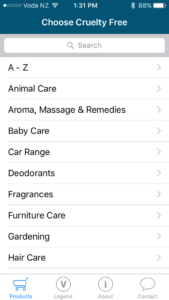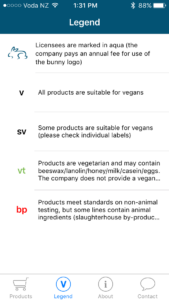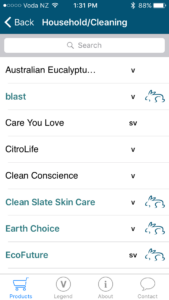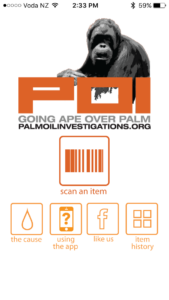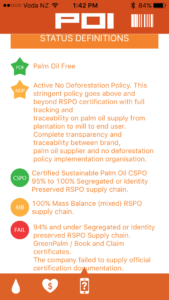This week will see the shops full to brim and sales going out the window. However, even though it’s a frantic time of year it’s still possible to make informed choices.
And here are 3 apps that will help you make those choices and shop ethically:
1. Choose Cruelty Free
Choose Cruelty Free (CCF) is an Australian, independent, non-profit organisation that actively campaigns against animal-tested cosmetics and household cleaning products. You may have come to recognise the CCF Rabbit logo on some products? This logo denotes that companies are proven to both – not test on animals and not use any animal derived products.
The app provides users with a listing of Australian brands that carry this logo (approved companies pay an annual fee to carry the logo) and also those that are proven vegan and vegetarian friendly. It also provides notes on whether products meet standards on non-animal testing but still may contain animal products.
What products are covered?
The app covers off items such as make up, skin care, fragrances, household cleaning and baby care.
The verdict
It’s a great idea and the app is simple and easy to use (basically just like a list). But it only provides a list of brands that have been approved (i.e. the good guys) so it makes me wonder about everything else. Does the absence of many brands mean they are possibly tested on animals? Or is there just not information available?
Availability
Available FREE for download for Android on Google Play and iPhone on the App Store.
Website: choosecrueltyfree.org.au
2. Sustainable Seafood
Seafood is extremely popular in the holiday season, who doesn’t love some prawns on the barbie?! But where does it come from and is it ethically and safely farmed? By this we mean farmed with minimal environmental impact, not over fished and not exposed to pollutants and chemicals.
Check out this app to find out all about your seafood and help you make responsible choices.
The app covers off most popular seafood purchased in Australia and works by a traffic light system:
- ‘green = better’. Not currently overfished, may still have some conservation concerns but are considered a better choice than the other categories.
- ‘yellow = eat less’. May be heavily targeted or caught using fishing methods that damage habitat or are associated with bycatch. May have other conservation concerns.
- ‘red = no’. Wild-caught species in this group may be overfished, or their capture involves significant bycatch of threatened or protected species. Farmed species include those produced by methods that place significant stress on our coasts and oceans.
How to guide
It’s an easy app to use with three ways to search – either alphabetically (which provides full listing), by category (green, yellow or red) or you can type in a key word. My opinion is the best way is by keyword – this way it cuts down the number you see but also provides you with a comparison by species.
When the listing is up, simply click into an individual one for more information and clarification as to the rating.
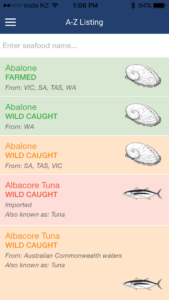
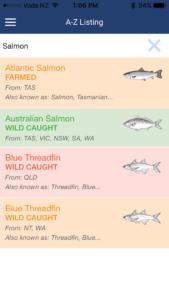

The verdict?
Very easy to use app, love the colour coded system as this gives a very quick indication of the sustainability rating of each species. And the user can go through to read more if they wish.
With around 90 species covered, it may not be the most comprehensive listing but the intention is to encompass the most common seafood consumers come across and I think it has done this well.
Availability
Available FREE for download for Android on Google Play and iPhone on the App Store.
Website: sustainableseafood.org.au
3. POI Palm Oil Barcode Scanner
We have probably all heard about palm oil and the controversy that surrounds it, but may not be entirely aware of what the story is.
Palm oil (derived from the palm fruit) is the most common vegetable oil used in products, however it is mostly listed just as ‘vegetable oil’ (or alternative names) in the ingredients – hence keeping it hidden from the consumer.
While palm oil itself is not the issue, the problem is the industry is largely unregulated and ungoverned and is linked with environmental issues such as deforestation – leaving endangered species such as Orangutan, Sumatran and Bornean Elephants, Rhino, Sun Bears and the Sumatran Tiger under threat.
What can we do
Ideally we should be avoiding products with palm oil in them but the labelling as mentioned above makes this almost impossible. That’s where the POI Palm Oil Barcode Scanner comes into play.
How does it work?
Use your phone’s camera to scan the barcode on a product in the supermarket. After which, the palm oil information will come up:
- Palm Oil Free (best result)
- Active No Deforestation Policy
- RSPO Certified Sustainable Palm Oil
- RSPO Mass Balance (mixed certified with uncertified)
- FAIL (worst result)
As you scan a product it saves it in a history and can be viewed either as a listing or a statistic view to show you the percentage of each category. Perfect to refer back to next time.
After scanning a product the app also gives the option of clicking through to an ‘alternative products’ listing. Which is great to see if the product you originally scanned didn’t come up with a great ranking and you would prefer to find something else similar.

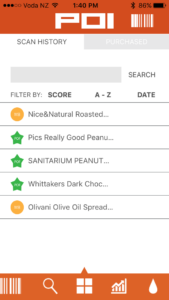
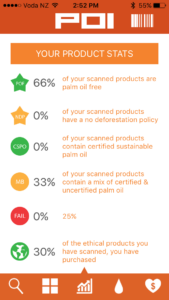
The verdict?
Functionality of this app was fantastic for me, straight forward, quick and very user friendly. All items that I scanned came up but I guess time will tell what is missing as I use the app more.
Would recommend the use of this app to assist in making informed choices in the supermarket
Availability
Available FREE for download for Android on Google Play and iPhone on the App Store.
Website: palmoilinvestigations.org

